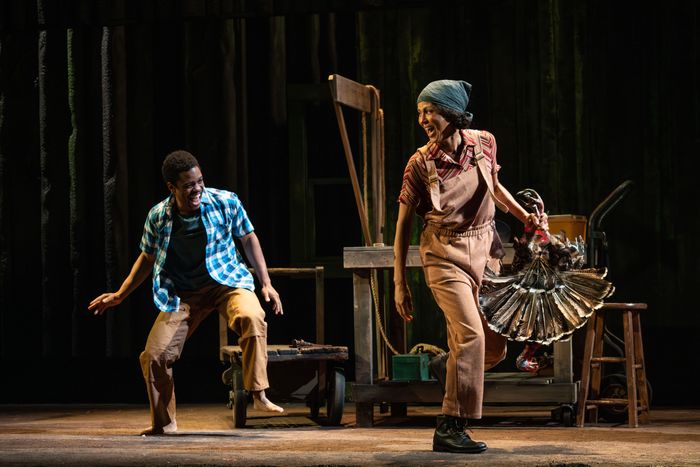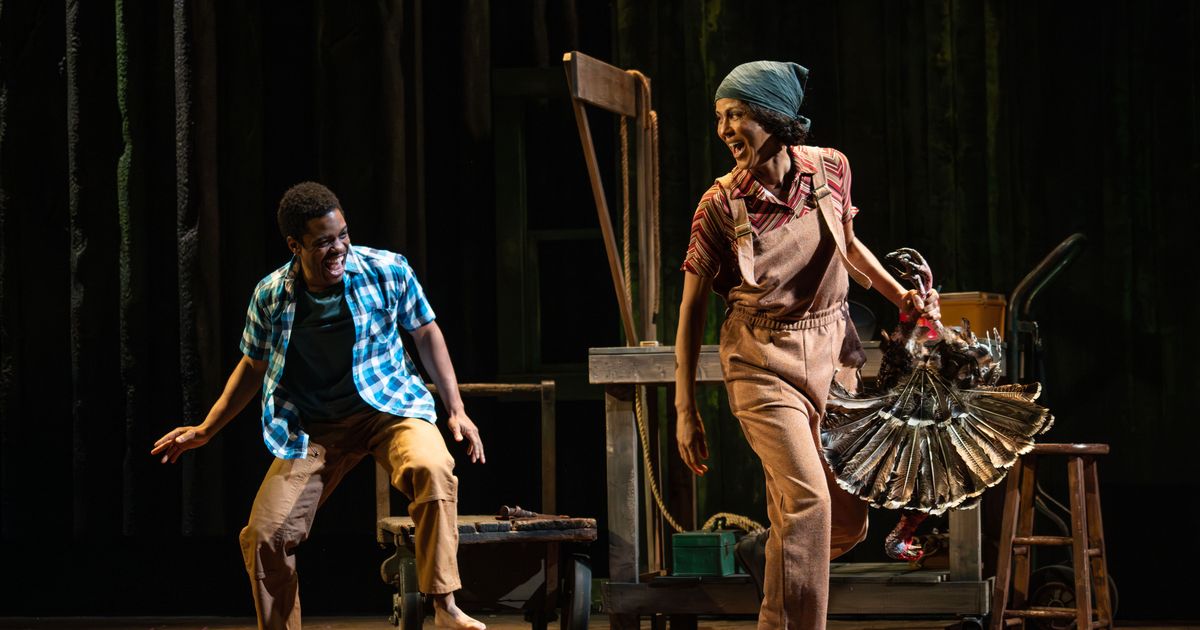
From The Refuge Plays, at the Laura Pels.
Photo: Joan Marcus
We often talk about an epic drama in terms of its demands on an audience — time, focus, even the physical strain of shifting around in a cramped chair. But the genre also asks a lot of a playwright: With the audience in mind, if you’re writing big and long, you have to build something sturdy. Clarity and structure become all the more valuable. Legible stakes and clearly defined themes, however heavy-handed, can hold an epic together, whereas more delicate touches — a finely filigreed monologue or twist of characterization — can’t be load-bearing as they might be in a smaller work.
In The Refuge Plays, Nathan Alan Davis has put together a three-part drama full of engaging small gestures that fail to add up. The drama is Davis’s follow-up after arriving in New York in 2016 with Nat Turner in Jerusalem, and it’s admirably ambitious; this production directed by Patricia McGregor runs three hours and 29 minutes. That’s not nearly as long as some epics, but certainly longer than your average nonprofit subscription theater program (The Refuge Plays is a co-production from New York Theatre Workshop and the Roundabout), especially at a time when most are cutting back. It’s got an intriguing hook: The trilogy begins more or less in the present with a Black family in a house hidden in the woods of Southern Illinois and then steps back one generation with each installment. But as it telescopes into the past, the series falls short of coherence, wandering away from itself and losing the audience.
The first of those plays, dubbed “Protect the Beautiful Place,” opens with a visit from a ghost, introducing Davis’s quasi-fantastical tone. We’re in the midst of a family drama haunted by something else. The set, by Arnulfo Maldonado, places an ordinary-looking living room in an ominous forest. Gail (Jessica Frances Dukes), the widowed acting matriarch of the family, is trying to hold together a precarious existence off the map, managing her daughter Joy (Ngozi Anyanwu) and grandson Ha-Ha (J.J. Wynder), as well as her mother-in-law, the formidable Early (Nicole Ari Parker, who has traded And Just Like That … glam for old-age makeup). Their concerns, at first, seem practical — food, firewood, etcetera — but Davis lets in eerie pronouncements and premonitions. Some of his magical-realist touches, like the haunting, give the play a fricative charge. Others are cutesy and flat. Ha-Ha is the type of precious, reading-obsessed young teen doted over by his elders that seems to exist primarily in plays, and Wynder never finds a way to make him real. McGregor, in general, has had difficulty calibrating everyone’s performances on an axis between the surreal and the ordinary. Some performers, like Dukes, can cut through it all by force of their own charisma; others, like Wynder and Mallori Taylor Johnson (who has the difficult task of playing Ha-Ha’s magic-pixie love interest) look lost.
According to an American Theatre interview, Davis developed Protect the Beautiful Place while studying at Juilliard, then expanded the single act into a trilogy after his classmates expressed interest in hearing more from the characters. You can understand where their interest came from; even in Protect the Beautiful Place’s unsteadiness, there’s a sense that there are more mysteries to be uncovered here if Davis had spent more time with this family. But as they pile more on top of this play instead of expanding it, Davis’s second two installments take such significant leaps that he loses track of a greater thread.
The second act, titled “Walking Man,” jumps back into the 1970s to focus on a younger version of Gail’s husband, Walking Man, played by Jon Michael Hill. There, Davis lets his story get too loose, throwing together a series of happenings — monologues about Walking Man’s travels over the world by foot, a visit from a pair of ghosts (Lizan Mitchell and Jerome Preston Bates, totally charming in unnecessary roles), a water pump that starts to work miraculously — which all have individual potential but crowd each other for attention. Davis works toward an idea of this house in the woods as a powerful haven, drawing in and protecting generations of women over time, but even at this length he doesn’t develop it fully. The production’s central character, Early, who’s now a few decades younger and still played by Parker, falls by the wayside during this act, and the lore that Davis has created for his tale takes the foreground. Other people discuss her personality and the reasons why she escaped to this place, but she herself is less often onstage.
Davis gives Early the most attention in his third act, “Early’s Place,” the best and simplest of the three. It’s a two-hander between a young Early and Crazy Eddie, played by Daniel J. Watts, a soldier back from World War II who finds her alone in the woods. The two actors, here, have a clear arc to play, testing each other and slowly coming to terms, and they seem energized by the direct situation. Watts is warm, and Parker is cold and flinty, gradually revealing bits of her well-protected softer side. After the discursive nature of Davis’s other two installments, “Early’s Place” works hard to pull The Refuge Plays toward a satisfying conclusion, to some idea of the compassion between two people powerful enough to birth a sanctuary in the woods. But that, alone, isn’t enough to make the epic click into place. The trilogy has strayed too far from Early. At the end of a saga, you might want to arrive at a feeling of homecoming, that we’ve seen a character land in the place she has always meant to be. I could see The Refuge Plays aiming at that for Early. But where this introduction, back in the past, might be positioned as a revelation — finally, we get to the root of who this character is — it instead registers as simply a first encounter. We’re meeting her for the first time.
The Refuge Plays is at the Laura Pels Theatre.
Source link












